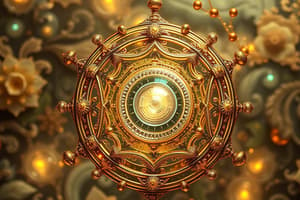Podcast
Questions and Answers
What was the primary material used during the Stone Age?
What was the primary material used during the Stone Age?
- Stone (correct)
- Copper
- Iron
- Steel
Approximately what year did the use of iron and steel begin?
Approximately what year did the use of iron and steel begin?
- 1000 BC
- 1500 BC
- 2000 BC
- 1200 BC (correct)
What scientific understanding enabled the development of Materials Science?
What scientific understanding enabled the development of Materials Science?
- Classical Mechanics
- Electromagnetism
- Thermodynamics
- Quantum Mechanics (correct)
What is the focus of Materials Science?
What is the focus of Materials Science?
When was the discovery of a cheap process to make steel made?
When was the discovery of a cheap process to make steel made?
What is the combination of physics, chemistry, and the focus on material properties and microstructure known as?
What is the combination of physics, chemistry, and the focus on material properties and microstructure known as?
What is the nature of the orbits of electrons in an atom according to quantum mechanics?
What is the nature of the orbits of electrons in an atom according to quantum mechanics?
What is the significance of the principal quantum number n in atomic orbitals?
What is the significance of the principal quantum number n in atomic orbitals?
What is the Pauli exclusion principle in atomic structure?
What is the Pauli exclusion principle in atomic structure?
What is the characteristic of the noble gases in the periodic table?
What is the characteristic of the noble gases in the periodic table?
What is the term for the ability of an atom to gain or lose electrons to form a closed shell?
What is the term for the ability of an atom to gain or lose electrons to form a closed shell?
What is the result of the formation of a closed shell in molecules?
What is the result of the formation of a closed shell in molecules?
What is the primary reason why metals have high electrical and thermal conductivity?
What is the primary reason why metals have high electrical and thermal conductivity?
Which of the following elements is not a metalloid?
Which of the following elements is not a metalloid?
What is the primary characteristic of the noble gases?
What is the primary characteristic of the noble gases?
What is the general trend for the light metals in the periodic table?
What is the general trend for the light metals in the periodic table?
What is the significance of the atomic number in the periodic table?
What is the significance of the atomic number in the periodic table?
Which element is an exception to the general rule that metals are solid at room temperature?
Which element is an exception to the general rule that metals are solid at room temperature?
What is the primary mechanism behind the formation of an ionic bond?
What is the primary mechanism behind the formation of an ionic bond?
What is the characteristic of ionic bonds in terms of directionality?
What is the characteristic of ionic bonds in terms of directionality?
In an ionic bond, which of the following is responsible for the attraction between the oppositely charged ions?
In an ionic bond, which of the following is responsible for the attraction between the oppositely charged ions?
What is the purpose of the fractional ionic bonding formula?
What is the purpose of the fractional ionic bonding formula?
Why do positive and negative ions alternate in a symmetrical fashion in an ionic solid?
Why do positive and negative ions alternate in a symmetrical fashion in an ionic solid?
What is the typical combination of bonding in real solids?
What is the typical combination of bonding in real solids?
What is the force that holds ions together, according to the given formula?
What is the force that holds ions together, according to the given formula?
What is the primary reason for the formation of covalent bonds?
What is the primary reason for the formation of covalent bonds?
What is the characteristic of a covalent bond?
What is the characteristic of a covalent bond?
What is the energy of a covalent bond represented by?
What is the energy of a covalent bond represented by?
What type of elements typically form covalent bonds with each other?
What type of elements typically form covalent bonds with each other?




